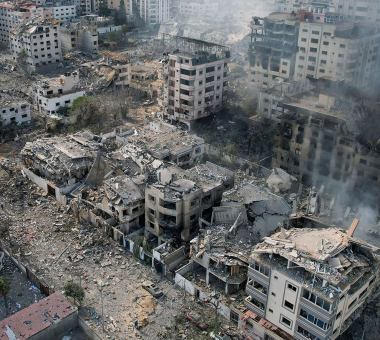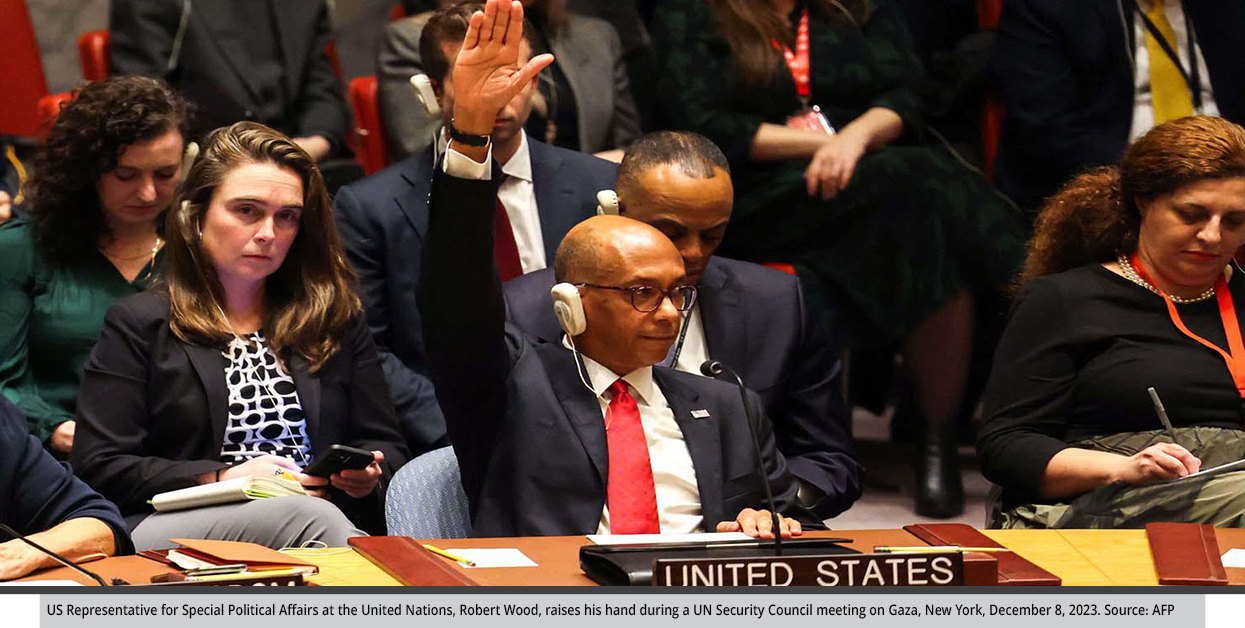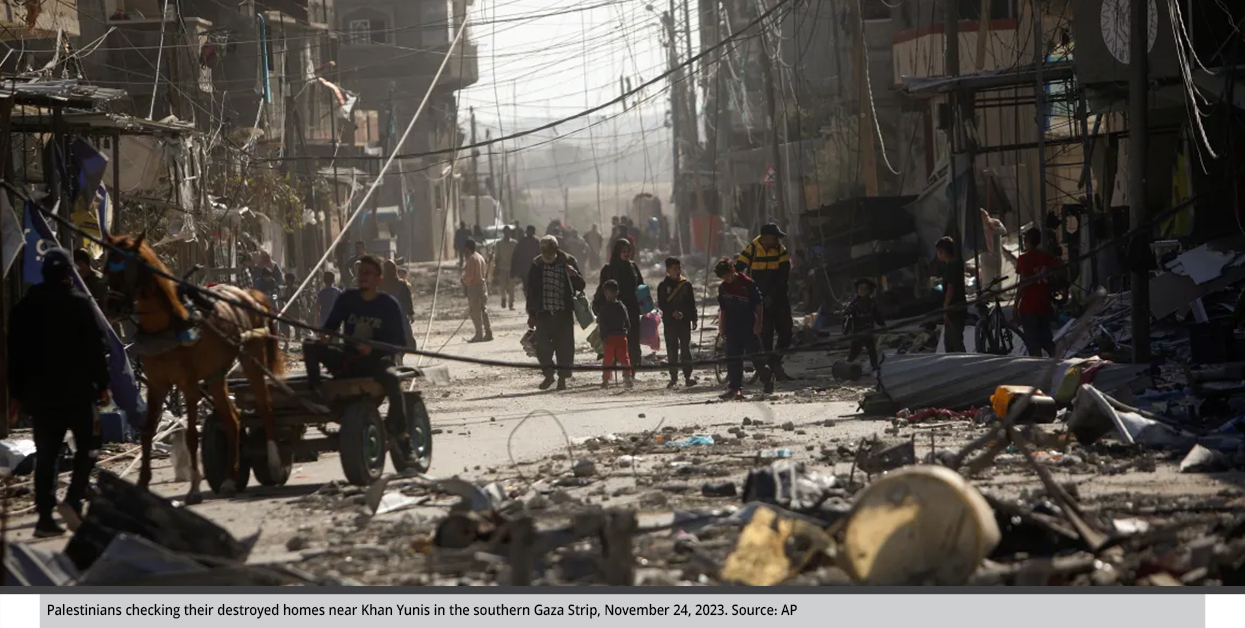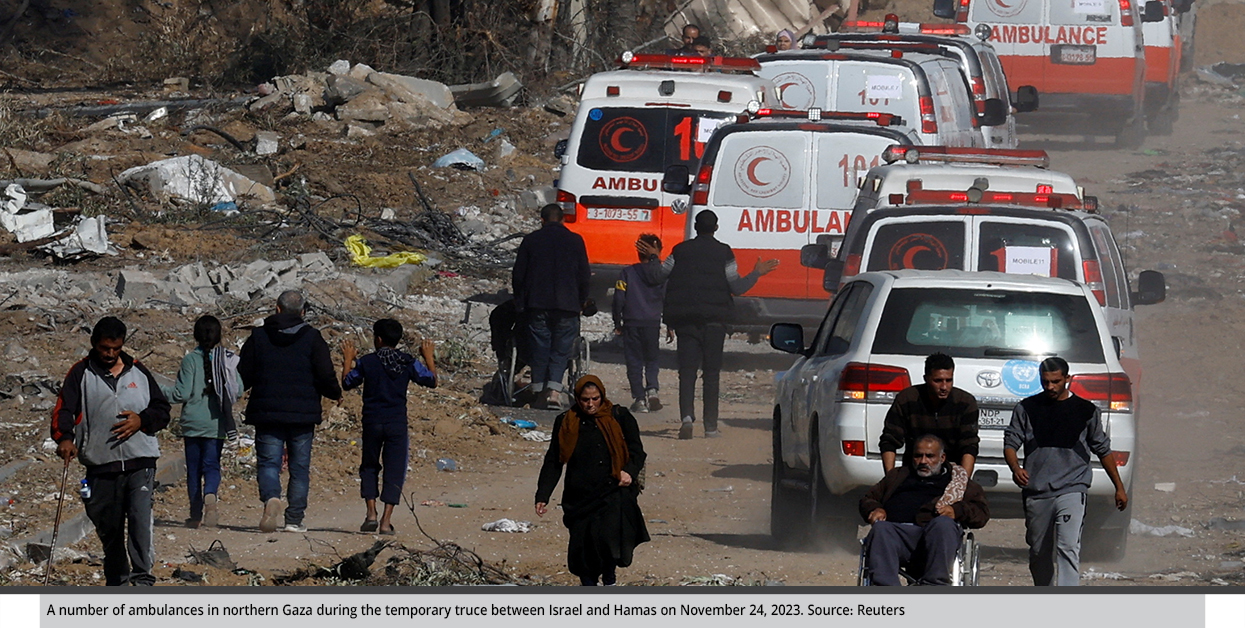Possible Outcomes of the Israeli War on the Gaza Strip After the Truce
The Israeli war on the Gaza Strip is managed according to changing rules, depending on the military situation, the local reactions of Hamas and Israel, and foreign pressures. This means that the war will not proceed according to any prepared plans, decisive objectives, or rules. Therefore, this paper addresses the possible outcome of the war after the truce and the variables that define such the war.
by Hazem Salem Dmour
- Release Date – Dec 10, 2023

The Israeli war on the Gaza Strip began a seven-day pause on November 24 after a humanitarian truce was agreed upon by the Israeli government and the armed Palestinian factions. During this period, Israel and Hamas exchanged prisoners and hostages. Yet no sooner had the truce ended than Israel resumed its military operations with more violence, reaffirming its war objectives: releasing the Israeli prisoners, dismantling Hamas’s military infrastructure, and exterminating Hamas.
Nevertheless, the war, now in its third month, is bringing several transformations in the military operations arena, with increased casualties for Hamas and Israel. Meanwhile, the Arab and international stance against the war has inspired a new set of possibilities for peace.
Circumstances and Positions
Neither the war’s circumstances nor its parties’ positions after the humanitarian truce ended showed any fundamental change.
First, President Joe Biden administration’s is still insisting on rejecting a cease fire. The United States vetoed a draft resolution by the UN Security Council that called for an immediate ceasefire in the Gaza Strip on December 8, 2023. The Biden administration believes that a ceasefire would be benefit Hamas, hinder Washington’s plans to change the governance and administration in Gaza after the war, and also hinder unifying Gaza with the West Bank under a central government led by the Palestinian Authority after it undergoes a fundamental restructuring processes.

Second, Israel still relates the date the war ends to the achievement of its objectives and the field data does not indicate that the Israeli army is close to achieving its goals. Seeking to subdue Hamas or achieve a tactical victory as soon as possible, the Israeli military operations were resumed with a more intense pace after the truce. Israel escalated its military operations and political measures against the West Bank and the Palestinian Authority, rejecting any political arrangements that would strengthen the role of the Palestinian Authority to undertake any future roles in the Gaza Strip.
Third, Hamas and other Palestinian factions want to associate the negotiation on the conscripted prisoners with the cessation of the Israeli war, in accordance with “all for all” formula in which all Israelis held by Hamas are released in exchange for the release of all Palestinians held by Israel. Hamas intensified its military operations within the Gaza Strip against the Israeli army, simultaneously with Israel staging a new front in the Khan Yunis areas, where Israel is attempting to assert itself as a major force in the Gaza Strip while rejecting any role for Hamas in the future governance of Gaza.
Possible Outcomes of the War After the Truce
The Israeli war on the Gaza Strip is managed according to rules that change depending on the military situation, the reactions of Hamas and Israel, and foreign pressures. This means that the war does not proceed according to any advance plans, decisive objectives, or rules. Therefore, the course of the war will be determined by the following set of variables.
First: A Second Humanitarian Truce
The renewal of the truce is based on the readiness of the mediators (the United States, Egypt, and Qatar); the increase of pressure on Hamas and Israel regarding political, military, and humanitarian decisions; and balancing the scales at the local and regional level. Despite the fact that a second truce will be more complicated because its terms will most likely involve releasing the military prisoners held by the Palestinian factions, finding a new formula remains possible in light of Hamas’ and Israel’s need for it.
More popular demands are being made to the war government inside Israel, especially after the success of the negotiations in releasing the first batch of prisoners. (The previous truce was based on the principle of one Israeli detainee in exchange for three Palestinian prisoners.) The pace of public pressure may rise after Israeli forces mistakenly killed three Israeli prisoners in December.
As for the Palestinian factions, they perhaps hope for a truce due to military and field pressures to start a new front in the south of the Gaza Strip, specifically in Khan Yunis, which the Israeli army is demanding its residents move from to reach safe areas in Rafah. This demand may double the humanitarian cost on the residents of the Gaza Strip and may have a reverse effect on how Gaza residents are hosted, let alone the high combat capabilities the Palestinian factions retain, according to statements from their leaders.

In addition, the United States recognizes that the war needs humanitarian truces to ease the domestic and foreign pressures on the American administration, as well as ease the international pressures on Israel stemming from the increased suffering of Gaza residents and the acute shortage of food, healthcare, and all other basic life necessities.
From this perspective, Hamas and Israel—for their own interests–-may agree on a second truce.
Israel views the second truce as a military tactic that would reduce the public’s cry for the release of prisoners. It would also ease the pace of international criticism of the Israeli government regarding the war. Israel would then redeploy its military to focus on field and aerial intelligence operations that would gather valuable information that may change the course of the war.
Meanwhile, a truce might help the Palestinian factions alleviate the suffering of the residents of the Gaza Strip by securing the release of Palestinian prisoners who Israeli courts sentenced to be imprisoned for extensive times. Certainly, gaining the release of national figures such as Marwan Barghouti and Ahmad Sa’adat would maximize the political gains of the Toofan Al-Aqsa operation in the eyes of Palestinians, whether in the West Bank, the Gaza Strip, or inside Israel.
Second: The War Continues at the Current Pace
A potential possibility is the continuation of the war at the same pace and high intensity until the end of the current month of December or with the beginning of the holiday season. Subsequently, the war will face two options: it will either continue no matter how long it takes until Israel achieves its goals or the intensity of the Israeli military operations will decrease at the beginning of the next year before becoming surgical operations, as predicted by the American military assessment.
In fact, both the battlefields expansion and the intensifying ferocity of the war in its post-truce phase are clear. This is primarily due to Hamas and Israel betting on time as a huge factor.
For instance, Israel wants to achieve field progress that would push Hamas to voluntarily exit the political and security landscape in Gaza. In doing so, Israel needs to achieve strategic results by destroying Hamas infrastructure, strength, and leadership, or at least inflict as much damage as possible on Hamas’s military capabilities, which would push Hamas to “surrender.” Eventually, Israel would rely on intelligence and informational work to finish off what remains of Hamas strategic infrastructure, its tunnel network, and its leadership.
Hamas, meanwhile, is attempting to maintain the momentum of its operations in order to confirm its ability to continue regardless of how long the war lasts. This will enable Hamas to improve the terms of negotiation in any upcoming negotiations and arrangements. In addition, Hamas is trying to establish the idea that toppling it is a relatively impossible goal to achieve, thereby pushing the Israeli war government and the United States to explore options that are less costly with fewer human and material losses rather than continuing the war in the coming phase.
Third: Reaching a Status where Operations Freeze
As the war enters its third month, perhaps the most prominent question currently circulating at the official international and popular levels is: How will the war end? It seems that neither Hamas nor Israel is capable of decisively bringing the war to an end, even on a tactical level. Based on the current field data, the idea of carrying on the war to an unknown date is an extremely difficult issue. The Israeli war government—which adopts the narrative of an open-ended war—does not provide further details about such a scenario, especially since Hamas is exerting a military effort to continue with the same momentum of fighting.
Thus, there is a possibility that the field data and other factors, such as international and humanitarian pressures, may lead to a stalemate on the ground and on the front lines, leading to a long ceasefire that avoids a phase of severe attrition in the military and economic capabilities of both parties in the war. This option becomes more likely to be implemented since Israel has firm control over the areas in northern Gaza that ensure its ability to isolate the Gaza Strip from the Israeli settlements in the Gaza Envelope.
Subsequently, it is likely that diplomatic efforts, through regional and international parties in addition to the truce mediators, will start seeking intermediate political solutions that urge Hamas and Israel to make certain concessions, whether in terms of mutually releasing prisoners or reaching arrangements for the future of Gaza.
In these arrangements, specifically the U.S. version, Hamas would accept to concede part of its rhetoric and arms, and ensure a “reasonable” role in the new Palestinian political system in the West Bank and the Gaza Strip in exchange for Israel ending its military presence there and accepting the terms of the new political arrangements for the Gaza Strip.
However, this may lead to other outcomes, such as the return of the Gaza Strip to its previous state before Israeli enacted its 2005 disengagement plan for the unilateral withdrawal of around 8,500 Jewish settlers from the Gaza Strip by shifting the focus of battle to the areas under Israeli control in northern Gaza.
Fourth: Displacement as Fait Accompli
The events on the field and the Israeli government’s actions have made the option of forced displacement of Palestinian citizens in the Gaza Strip a fait accompli. The Israeli army is imposing a military siege on the northern Gaza Strip by preventing the entry of food and fuel as it did during the previous truce while conducting extensive bombing operations along its borders. Israel’s goal is to demolish any Palestinian military—and civilian—infrastructure and impose a siege on most medical services while targeting gatherings of displaced people in schools and hospital courtyards.

In the post-truce phase, the Israeli army began its operations in the south of the Gaza Strip, specifically in the Khan Yunis area in the south, which hosts the largest number of displaced people from the northern areas. The Israeli army once again adopted the same strategy it previously employed in the north: forcing residents to move further south—in this case, an upheaval of Khan Yunis residents toward towards Rafah, a southern city on the border with Egypt.
In addition, the Israeli army sabotaged the main water lines connecting Rafah to Khan Yunis, leading to water cuts in large areas of Khan Yunis. The Israeli army also adopted the policy of “fire belts” (intensive missile bombings) that cause massive human casualties and destruction to a city’s infrastructure.
Israel is seeking to impose a different field reality and geography for the Gaza Strip than how it was before October 7. By narrowing the livable spaces for the residents of the Gaza Strip—by creating a scarcity of basic resources and services for the hundreds of thousands of residents its army has forced into narrow geographical areas—Israel is implementing displacement, making it a fait accompli even if it has not explicitly announced it.
Finally, what will shape the end of the Israeli war on the Gaza Strip will be determined by a set of variables, foremost of which is the U.S. administration’s conclusion that the continuation of the war is reducing Biden’s electoral chances, and that international and regional pressures reach an unprecedented level that necessitates stopping the war and halting its negative repercussions on Israel’s reputation. On the other hand, Hamas and Israel may reach a level of military exhaustion that pushes them to reach a humanitarian truce, which implicitly evolves into a comprehensive ceasefire.
No matter which possibility is realized, ending the war with a military victory seems unlikely. Only political settlements can pave the way for solutions that ensure a safe and secure future for the Gaza Strip. What will determine that future is the shape of the field where the war comes to a halt.

Hazem Salem Dmour
General Manager / Specialized Researcher in International Relations and Strategic Studies
 العربية
العربية